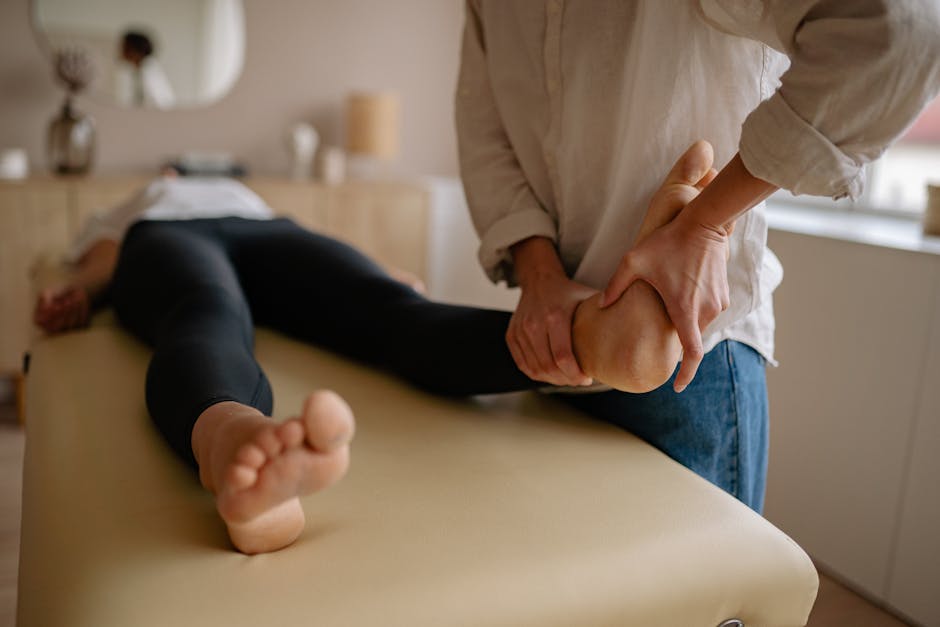Holistic Approaches to Joint Pain: A Comprehensive Guide
Joint pain can be a debilitating condition that affects millions of people worldwide. Whether it’s caused by arthritis, injury, or other underlying health issues, finding effective ways to manage and alleviate joint pain is crucial for improving quality of life. While traditional medical treatments like medication and surgery can be effective, many individuals are turning to holistic approaches to joint pain for a more natural and sustainable solution.
The Holistic Approach: What Does it Entail?

Before delving into the specifics of holistic approaches to joint pain, let’s first understand what the term “holistic” means. Holistic medicine is a form of healing that considers the whole person body, mind, spirit, and emotions in the quest for optimal health and wellness. Instead of focusing solely on symptoms, holistic approaches aim to address the underlying causes of disease and pain.
When it comes to joint pain, holistic approaches may involve a combination of lifestyle modifications, dietary changes, physical therapies, alternative treatments, and mind-body practices. By taking a comprehensive and multifaceted approach to joint pain, individuals can often achieve significant relief and improved mobility without relying solely on conventional medications or surgeries.
1. Nutrition and Diet

One of the key pillars of holistic approaches to joint pain is nutrition and diet. Certain foods and nutrients have been shown to have anti-inflammatory properties, which can help reduce swelling and pain in the joints. For example, omega-3 fatty acids found in fatty fish like salmon and mackerel have been linked to decreased inflammation in the body.
Additionally, foods rich in antioxidants, such as berries, leafy greens, and nuts, can help protect the joints from oxidative stress and damage. On the other hand, processed foods, sugar, and saturated fats can contribute to inflammation and worsen joint pain. By adopting a balanced and nutrient-dense diet, individuals can support joint health and reduce pain naturally.
Case Study: Mary, a 55-year-old woman with osteoarthritis, implemented a plant-based diet rich in fruits, vegetables, whole grains, and lean proteins. Within a few months, she noticed a significant decrease in joint pain and stiffness, allowing her to engage in activities she once found challenging.
2. Exercise and Movement

Physical activity is another crucial component of holistic approaches to joint pain. While it may seem counterintuitive to exercise when experiencing joint pain, movement can actually help improve flexibility, strength, and range of motion in the joints. Low-impact exercises like swimming, yoga, and walking can be particularly beneficial for individuals with joint pain.
Strength training exercises that target the muscles surrounding the joints can provide added support and stability, reducing the risk of injury and further pain. Additionally, regular physical activity releases endorphins, which are natural pain relievers that can help alleviate joint discomfort and improve mood.
Research has shown that individuals who engage in regular exercise experience less joint pain and better overall function compared to those who lead sedentary lifestyles. By incorporating movement into daily routines, individuals can promote joint health and reduce pain in a holistic way.
3. Alternative Therapies

In addition to nutrition and exercise, holistic approaches to joint pain often incorporate alternative therapies that focus on healing the body naturally. Acupuncture, for example, is a traditional Chinese medicine practice that involves inserting thin needles into specific points on the body to alleviate pain and promote healing.
Chiropractic care is another alternative therapy that emphasizes spinal alignment and joint mobilization to reduce pain and improve function. Massage therapy, herbal remedies, and aromatherapy are also popular holistic treatments for joint pain that can target inflammation, promote relaxation, and enhance overall well-being.
Case Study: John, a 45-year-old man with rheumatoid arthritis, sought out acupuncture treatments to manage his joint pain and inflammation. After several sessions, he experienced a significant reduction in pain and stiffness, allowing him to reduce his reliance on pain medications.
4. Mind-Body Practices
Another integral aspect of holistic approaches to joint pain is the integration of mind-body practices that emphasize the connection between mental and physical health. Practices like meditation, mindfulness, and guided imagery can help individuals manage stress, reduce pain perception, and improve overall well-being.
Stress and anxiety can exacerbate joint pain by triggering inflammatory responses in the body and increasing muscle tension. By incorporating relaxation techniques into daily routines, individuals can effectively manage these psychological factors and alleviate joint discomfort.
Research has shown that mind-body practices can have a profound impact on pain management and quality of life for individuals with chronic conditions like arthritis. By cultivating a sense of inner peace and mindfulness, individuals can better cope with the challenges of living with joint pain.
5. Holistic Approaches in Traditional Medicine
While holistic approaches to joint pain often involve natural and alternative therapies, they can also be integrated into traditional medical practices to enhance treatment outcomes. Many healthcare providers are now recognizing the importance of a holistic approach in managing chronic pain conditions like arthritis and are incorporating complementary therapies into their treatment plans.
For example, a rheumatologist may recommend a combination of medication, physical therapy, and acupuncture to address both the symptoms and underlying causes of joint pain in a comprehensive way. By tailoring treatment plans to individual needs and preferences, healthcare providers can offer a more personalized and holistic approach to joint pain management.
Case Study: Sarah, a 60-year-old woman with fibromyalgia, worked with her healthcare team to develop a holistic treatment plan that included medication, gentle exercise, nutritional counseling, and mindfulness practices. By addressing all aspects of her condition, Sarah experienced significant improvements in pain, fatigue, and overall quality of life.
6. Common Misconceptions about Holistic Approaches
Despite the growing popularity of holistic approaches to joint pain, there are still some common misconceptions and myths surrounding these alternative therapies. One of the most prevalent misconceptions is that holistic treatments are ineffective or lack scientific evidence to support their use.
While it’s true that some holistic therapies may not work for everyone, many have been extensively studied and shown to be safe and effective in managing joint pain. For example, acupuncture has been endorsed by the World Health Organization for its ability to relieve pain and improve function in various musculoskeletal conditions.
Another misconception is that holistic approaches are time-consuming or costly compared to traditional medical treatments. In reality, many holistic practices can be easily integrated into daily routines and may be more cost-effective in the long run, especially when considering the potential savings on medication and surgery.
7. Expert Opinions on Holistic Approaches
As holistic approaches to joint pain continue to gain popularity, many experts in the fields of integrative medicine, rheumatology, and physical therapy are advocating for a more comprehensive and patient-centered approach to pain management. Dr. Jane, a renowned rheumatologist, believes that holistic therapies play a crucial role in addressing the complex nature of joint pain and should be considered alongside conventional treatments.
Dr. Michael, a licensed acupuncturist, emphasizes the importance of individualized care and tailoring treatment plans to each patient’s unique needs and preferences. By taking a holistic approach to joint pain, healthcare providers can empower patients to take an active role in their healing journey and achieve long-lasting relief.
Conclusion
In conclusion, holistic approaches to joint pain offer a comprehensive and integrative way to manage and alleviate pain in a natural and sustainable manner. By addressing the root causes of joint pain and considering the interconnectedness of body, mind, and spirit, individuals can achieve significant improvements in pain, mobility, and overall quality of life.
Whether through nutrition and diet, exercise and movement, alternative therapies, mind-body practices, or a combination of these approaches, holistic treatments can provide a holistic and personalized approach to joint pain management. By incorporating these holistic strategies into daily routines and working closely with healthcare providers, individuals can take control of their joint health and well-being.
Remember, holistic approaches to joint pain are not a one-size-fits-all solution and may require experimentation and patience to find what works best for each individual. By exploring the diverse and complementary therapies available, individuals can discover a unique and personalized approach to managing joint pain that resonates with their values and goals.
So, whether you’re living with arthritis, recovering from an injury, or simply looking to improve your joint health, consider incorporating holistic approaches into your pain management regimen. Your joints will thank you for it!




